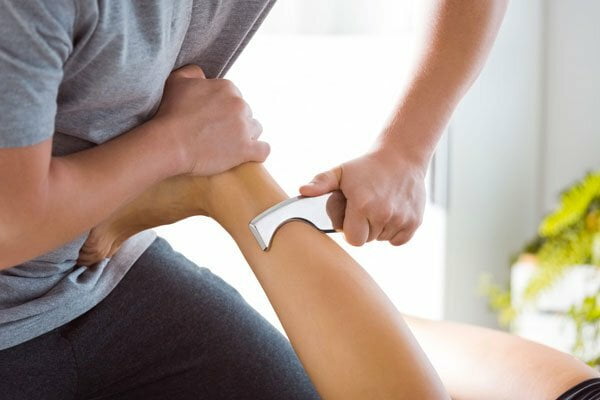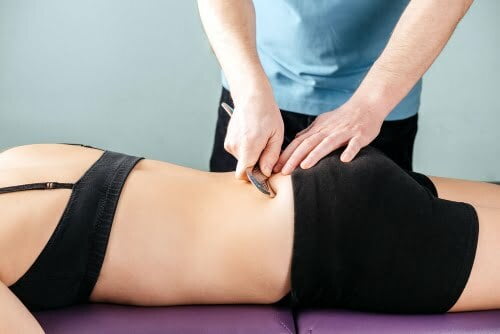
Soft tissue injuries can leave you with scar tissue and adhesions that cause you pain and limit your mobility. Most soft tissue traumas fall into two groups: Acute and overuse. An acute injury includes sprains, strains, and contusions resulting from sharp and sudden trauma. You may get an acute injury during physical activities, such as sports, or during an accident, like a car wreck or a hard fall. Overuse injuries can include tendonitis, bursitis, or straining that result from a particular activity that is frequently repeated.
The Graston technique can be used to provide treatment that promotes pain relief.
What Is the Graston Technique?
The Graston technique is an innovative method that uses handcrafted stainless steel instruments that assist in soft tissue mobilization. This allows Physiotherapists to identify and efficiently break down scar tissue and myofascial adhesions on a patient, which reduces pain and improves range of motion. The instrument-assisted soft tissue method movement can resonate over irregularities in the soft tissue, as the instrument will vibrate gently in the Physiotherapist’s hands, which makes it a useful tool to locate pain in the affected area.
The stainless steel tools used in the Graston technique are concave and convex-shaped with round edges. They are shaped this way to make it more efficient to detect areas of soft tissue fibrosity.
Benefits
Injuries to the soft tissue will usually form scar tissue due to the healing process of living tissues. While scar tissue won’t be the root of the pain, it can cause stiffness that limits the range of motion in a patient.
The many benefits of the Graston technique may include:
- Faster treatment, rehabilitation, and recovery
- Inflammation reduction
- Pain relief
- Resolution of chronic conditions thought to be permanent
- Decreased need for anti-inflammatory medicine
- Increased functional mobility and the ability to perform daily tasks
- Increase volume and blood flow to the injured areas for faster healing
- Boost cellular activity
- Breakdown collagen cross-links
How Does It Work?
You can think of the Graston technique as a more intense version of manual therapy. A trained Physiotherapist may use the Graston instruments in two ways:
- Firstly, identify muscle knots or restrictions by running the tool over your skin to feel for fibrosity or scar tissue that’s causing you pain and restricting your mobility.
- Second, use the stainless steel tools to gently massage and break up the tissue to restore functional mobility.
Rubbing over the adhesions in the affected area will help further the healing process from a soft tissue injury. The amount of pressure and speed used during the Graston technique will depend on the nature of your condition. After each therapy treatment, the affected areas should be stretched out, and Physical Therapists will provide patients with ice packs if there is any pain or soreness.
Treatment
Exercising, stretching, and strengthening are recommended to be used in conjunction with the Graston technique to help the injured tissues heal.
Treatment will include the following:
- Cardiovascular Warm-Up: Cardiovascular exercises are critical before using the Graston technique. This is due to the increase in blood flow to the injured area, which optimizes the environment for healing. Most areas of the body can benefit from a warm-up, such as the hands, arms, shoulders, neck, back, and legs.
- Graston Instrument Massage: Treatments require a specific amount of pressure and strokes. The Physiotherapist will use the carefully selected tools for a specific amount of time on the injured spot.
Stretching/Cool Down: Afterward, patients will engage in some light stretching and strengthening exercises to assist with mobility impairment. This is followed by cold therapy, usually with ice packs, to decrease swelling or pain after treatment.

What Is the Graston Technique Used For?
The Graston Technique can be used to treat many acute and chronic conditions, like:
- Neck pain
- Shoulder pain
- Lower back pain
- Knee pain
- Quadricep pain
- Rotator cuff tears
- Meniscal tears
- Tendonitis
- Plantar fasciitis
- Tennis elbow
- Golfer’s elbow
- Carpal tunnel syndrome
- Shin splints
- Fibromyalgia
Does It Hurt?
Like many other soft tissue treatments, the Graston technique can be uncomfortable but not excruciatingly painful. After physical therapy treatment, most patients may experience redness or minor bruising on the skin over the affected area. Physiotherapists will recommend an ice pack application for 15-20 minutes following the treatment to ease soreness or discomfort.
Is It Safe?
The Graston technique is a non-invasive and non-surgical method that is generally safe. However, while it’s a prominent technique that’s often used in clinics around the world, it’s not safe for everyone with soft tissue-related injuries.
This treatment should not be used for patients with:
- High blood pressure
- Fractures that aren’t fully healed
- Kidney disorders
- Blood-thinning medications
- Open wounds
- Tumours around the soft tissue injury
- Pregnant women should also avoid this treatment
While results can vary, patients may notice improvements in pain and range of motion within the first few sessions using this physical therapy technique. If you’re suffering from intense discomfort resulting from a soft tissue injury, make an appointment at our Winnipeg physiotherapy clinic today. Our trained Physiotherapists can provide the correct treatment and application of the Graston technique to ease your return to a pain-free life.



